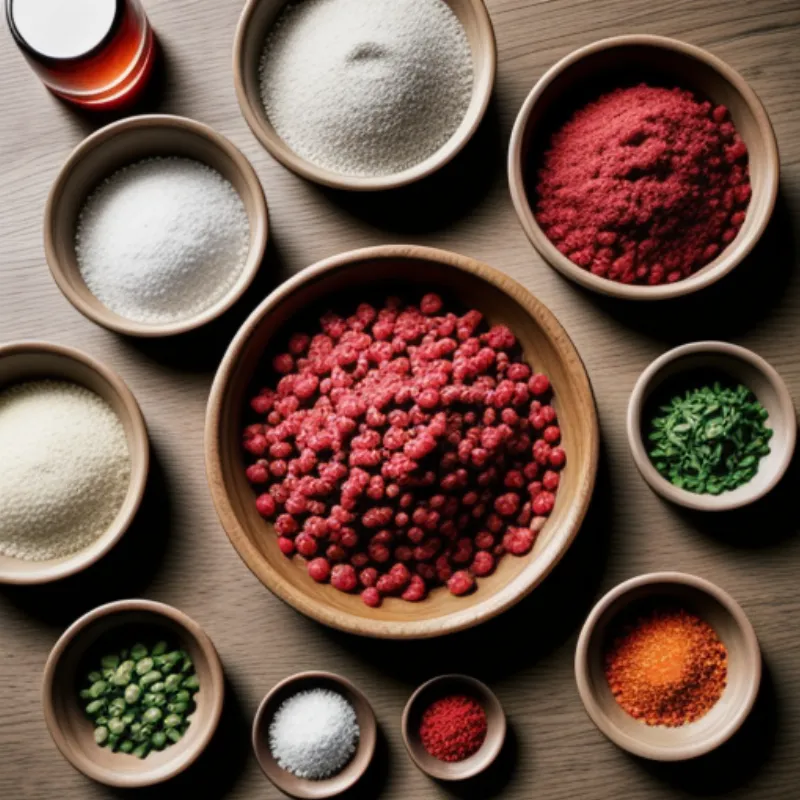Chorizo, the vibrant and intensely flavorful Spanish sausage, needs no introduction. With its deep red hue and a captivating blend of smoky paprika and savory spices, chorizo has the power to transform any dish into a culinary masterpiece. While enjoying chorizo from a local butcher is always a treat, making it at home is an immensely satisfying experience that allows you to tailor the flavors to your liking.
This comprehensive guide will walk you through the entire process of making authentic chorizo from scratch. Be prepared to embark on a culinary adventure as we unlock the secrets to creating this Spanish delicacy right in your own kitchen!
Gathering Your Chorizo Ingredients
The beauty of making chorizo lies in the ability to customize the flavors to your heart’s content. However, certain core ingredients form the foundation of this iconic sausage. Here’s what you’ll need:
- Pork: 2 pounds of pork shoulder, coarsely ground. You can also use a mix of pork shoulder and pork belly for a richer flavor.
- Fat: 1 pound of pork fat, finely ground. This is essential for achieving the characteristic juicy texture of chorizo.
- Paprika: This is where the magic happens! Use 3 tablespoons of Spanish smoked paprika (pimentón) for an authentic smoky flavor. You can experiment with different types of paprika, such as sweet (dulce) or hot (picante), to adjust the heat level.
- Garlic: 4 cloves, minced.
- Salt: 2 teaspoons of sea salt, or to taste.
- Other Spices: 1 teaspoon each of ground cumin, oregano, and black pepper. Feel free to get creative and add your favorite spices, such as cayenne pepper for extra heat or fennel seeds for a subtle anise flavor.
- Red Wine Vinegar: 2 tablespoons. This adds a touch of acidity and complexity to the chorizo.
- Casings: About 2 feet of hog casings, rinsed and soaked in cold water for at least 30 minutes.
Essential Tools for Chorizo Making
Before we dive into the process, gather the following tools:
- Meat Grinder: This is optional but highly recommended for achieving the perfect texture.
- Sausage Stuffer: For stuffing the chorizo mixture into casings.
- Kitchen twine: For tying off the chorizo links.
Crafting Your Homemade Chorizo: A Step-by-Step Guide
-
Prepare the Meat: In a large bowl, combine the ground pork, pork fat, paprika, garlic, salt, and other spices. Using your hands, mix everything thoroughly until all the ingredients are evenly distributed.
-
Marinate the Mixture: Cover the bowl with plastic wrap and let the chorizo mixture marinate in the refrigerator for at least 2 hours, or preferably overnight. This allows the flavors to meld beautifully.
-
Test the Flavor: Before stuffing the chorizo, it’s crucial to cook a small patty of the mixture to check for seasoning. Adjust the salt and spices according to your preference.
-
Stuff the Casings: If you’re using a sausage stuffer, follow the manufacturer’s instructions. If not, you can use a funnel attachment to your meat grinder. Carefully fill the casings, making sure to avoid air pockets.
-
Link the Chorizo: Twist the chorizo into 4-inch links, tying them off with kitchen twine.
-
Air-Dry (Optional): For a more intense flavor and firmer texture, you can air-dry the chorizo in a cool, dry place for a few hours or overnight.
 Ingredients for making chorizo
Ingredients for making chorizo
Cooking and Enjoying Your Homemade Chorizo
The best part? Your homemade chorizo is ready to be cooked and devoured!
- Pan-frying: Slice the chorizo into rounds and pan-fry over medium heat until crispy and cooked through.
- Grilling: Grill the chorizo links over medium heat, turning occasionally, until they’re nicely charred and cooked through.
- Adding to Stews and Soups: Chorizo adds incredible depth of flavor to stews, soups, and bean dishes.
Tips for Chorizo Perfection
- Use high-quality ingredients: The quality of your ingredients will directly impact the flavor of your chorizo.
- Don’t overmix the meat: Overmixing can result in a tough texture.
- Be gentle when stuffing the casings: Avoid overstuffing, which can cause the casings to burst during cooking.
 Cooking chorizo on a cast-iron pan
Cooking chorizo on a cast-iron pan
Exploring the World of Chorizo
Chorizo’s versatility knows no bounds. Add it to paella for a smoky kick, crumble it over pasta for a burst of flavor, or simply enjoy it as a tapa with a glass of Spanish red wine. You can also explore regional variations of chorizo, such as the spicy chorizo from the Basque Country or the milder chorizo Riojano.
FAQs About Making Chorizo
Can I make chorizo without casings?
Absolutely! Simply shape the chorizo mixture into patties or logs and cook them without casings.
How long can I store homemade chorizo?
Refrigerate cooked chorizo for up to 3 days or freeze it for up to 3 months.
What can I substitute for pork fat?
While pork fat is traditional, you can substitute it with beef fat or even duck fat for a richer flavor.
Embracing the Art of Homemade Chorizo
Making your own chorizo is a rewarding culinary experience that allows you to connect with the rich traditions of Spanish cuisine. With this step-by-step guide, you’ll be well on your way to crafting flavorful, authentic chorizo that will impress your family and friends. So gather your ingredients, roll up your sleeves, and let the chorizo-making adventure begin!
And if you’re eager to delve deeper into the world of homemade delicacies, be sure to check out our other recipes, such as our guides on how to make gumbo or how to make jambalaya, which also offer unique flavor profiles and cooking techniques.
